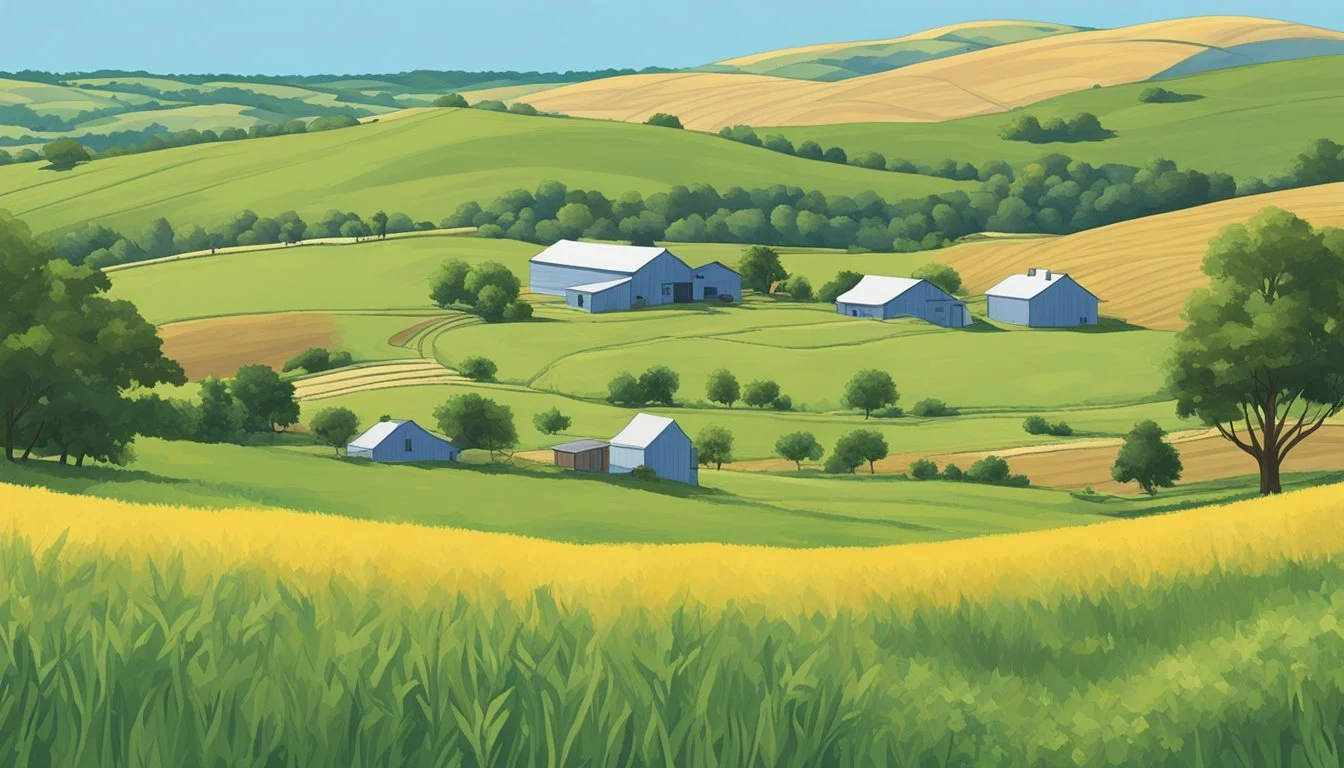Kansas Farm Land for Lease
Opportunities for Agricultural Advancement
This Article is Part of Our Guide on Navigating Agricultural Leases Across the US
Kansas has long been synonymous with agriculture, boasting a rich history rooted in the heartland of America's crop production. Today, the state offers a variety of options for those interested in leasing farmland, catering to a range of agricultural needs from crop farming to livestock grazing. With an expansive array of land types, including irrigated, non-irrigated, and pasture, Kansas provides opportunities for both established farmers and newcomers to the industry to find land that suits their specific agricultural pursuits.
The state's diverse agricultural landscape is underscored by its evolving marketplace. New leasing opportunities frequently become available, appealing to farmers who seek specific types of land to complement their farming operations. Kansas's farm rental rates have seen an upward trend over time, reflecting the demand for quality farmland. The leasing process in Kansas is supported by resources that help potential lessees analyze the market, including access to rental rate statistics and land availability alerts, ensuring that interested parties are well-informed when making leasing decisions.
Prospective tenants looking to lease farmland in Kansas are advised to consider a variety of factors that impact their farming operations, such as soil quality, water availability, and the proximity to markets. They are also encouraged to become familiar with local agricultural regulations and to engage in thorough due diligence before entering into a leasing agreement. This careful approach promises a more fruitful and stable partnership between landowners and tenants, leading to sustained agricultural productivity on Kansas farmland.
Understanding Kansas Farm Land Leasing
In Kansas, leasing farm land is a common practice, allowing for the productive use of agricultural land without the financial burden of ownership. This arrangement involves specific lease rates and legal considerations to protect the interests of both the landowner and the tenant.
Types of Land Leases
There are several types of land leases in Kansas, which include:
Cash Rent Lease: The tenant pays a set lease rate per acre or a flat fee for the exclusive right to use the land for agricultural purposes.
Crop Share Lease: The landowner and tenant share the costs and returns of the crops grown, typically with the landowner receiving a percentage of the crop or crop proceeds.
Flexible Cash Lease: The lease rate is adjustable based on yield, price, or revenue, providing flexibility depending on agricultural performance.
Leasing Vs. Owning
When comparing leasing versus owning agricultural land:
Leasing: Offers a lower capital investment and flexibility, allowing farmers without the means to own land to still engage in agricultural production. Leasing rates can vary but are typically influenced by land quality, location, and demand.
Owning: Provides long-term control of land use and the benefits of real estate appreciation. However, owning requires a significant upfront investment and the ability to manage and finance the property.
Legal Considerations
Legal considerations are essential in Kansas for farm land leasing:
Lease Agreements: A lease should be in writing to clearly outline the rights and obligations of each party. Although oral leases exist, written leases prevent misunderstandings and provide legal certainty.
State Statutes: Kansas law requires specific actions for terminating tenancies, such as providing written notice delivered no later than 30 days before March 1st for an annual lease.
USDA Programs: Tenants and landowners must consider how leasing may affect eligibility for USDA programs, and ensure compliance with program requirements.
By navigating these facets with diligence, both tenants and landowners can maintain successful leasing arrangements.
Evaluating Kansas Land for Lease
When looking to lease farm land in Kansas, it's crucial to consider acreage, soil and crop suitability, and water resources, which can significantly impact the land's productivity for both crop production and livestock grazing.
Acreage and Property Size
The property size, typically measured in acres, dictates the scale of agricultural operations that can be conducted. Kansas offers a varied range of property sizes suitable for different purposes:
Tillable Farming Ground: Larger acreages are necessary for extensive crop production.
Cattle Pastures and Grazing Land: Adequate acreage is essential to support herd size without overgrazing.
Soil and Crop Suitability
Soil quality and type play pivotal roles in determining the suitability for different crops. Kansas land varies from region to region, but here are key considerations:
Arable Agricultural Land: Evaluate soil fertility and potential need for amendments.
Crop Rotation: Some areas are ideal for crop rotation to maintain soil health.
Water Resources and Irrigation
Water access cannot be overlooked, particularly in crop-specific areas that require irrigation:
Irrigated Land: Areas with established irrigation systems command higher rental rates.
Non-Irrigated Land: Depending on the rainfall patterns, non-irrigated land may have limitations for certain crops or require investment in irrigation infrastructure.
Financial Aspects of Farm Land Leases
The financial dynamics of farm land leases in Kansas are influenced by market trends and lease structures, affecting both landowners and operators financially.
Determining Lease Rates
Lease rates for agricultural land are a critical aspect of farming leases. They can vary widely and are typically based on several key factors:
Land quality: Better quality land commands higher rates.
Local market rates: Competitive local markets influence lease prices.
Lease type: Whether it's a cash lease or a crop-share lease.
Lease rates are often reflected in listing prices and can be influenced by historical trends of the region. For instance, a shift from crop-share to cash leases can affect the pricing strategies for both lessors and lessees.
Managing Costs and Profits
For lessors (landowners), the key to managing costs and profits lies in setting lease rates that align with the land's ability to produce revenue without pricing themselves out of the competitive market. For lessees (farmers or operators), they must balance the lease rate against their potential yield and overarching market prices for crops to ensure profitability. This balance requires a thorough understanding of:
Input costs
Historical yield data
Current market conditions
Proper financial management and strategy can lead to a successful leasing arrangement where both parties achieve their financial goals.
Finding Farm Land for Lease in Kansas
Those in search of farm land for lease in Kansas have various avenues to explore, from local listings and brokers with intimate knowledge of county-level real estate, to comprehensive online platforms offering a range of properties for lease.
Local Listings and Brokers
Local real estate listings and brokers are pivotal in finding available farm land for lease. They often have detailed knowledge of the area and can provide insights into specifics like acreage, land quality, and leasing terms. Renters should consider:
County-Level Real Estate: With varying rental rates and land types, brokers can guide potential lessees through the local real estate landscape, ensuring they find land that meets their requirements.
Properties for Lease: By working with local brokers, those interested in renting have access to the latest properties for lease, including those not listed online.
Online Platforms and Services
Online services can streamline the search for Kansas farm land for rent, providing tools and services that enhance the discovery and leasing process. Key features include:
Acreage for Lease: Online platforms list comprehensive details regarding the size and type of farm land available, from small plots to extensive acreage.
Land for Lease: These services may offer a variety of land types for rent including crop land, cattle pastures, and grazing land.
Listing Age: Up-to-date listings ensure users have access to the most current properties for lease. Some platforms offer alert programs that notify users when new properties matching their criteria become available.
Potential renters can confidently navigate the leasing landscape with these resources, assured that they have the most relevant and up-to-date information at their disposal.
Kansas Regional Insights
The diverse agricultural regions of Kansas offer varied opportunities for land leasing, each with its own characteristics influenced by geography and local economies.
Eastern Kansas Agricultural Profile
Eastern Kansas is characterized by its relatively wet climate and fertile soils, making it suitable for crop production. Rental rates in this region have been expected to increase by 11% for the 2024 crop year. A significant portion of the land here is dedicated to growing soybeans, (how long do soybeans last?) corn, and wheat. With the profitability of farms in 2023 and 2024 being a factor, land lease rates reflect these conditions. Wildlife management also plays a role in this region, balancing the needs of agriculture with environmental stewardship.
Western Kansas Farming Landscape
Conversely, Western Kansas presents a drier climate, with land often dedicated to wheat cultivation and large cattle pastures. The projected rental rate increase for this region is a modest 2%, due to factors such as less precipitation and fewer crop options. However, this leads to cheaper grazing land availability, which is advantageous for cattle ranching. The vast expanses in this area support significant cattle operations, contributing to the state's reputation as a leader in beef production.
Best Practices for Leasing Farm Land
When entering a farm land lease, both parties should focus on detailed agreements that secure mutual benefits and encourage responsible land management.
Creating a Solid Lease Agreement
To establish a solid lease agreement, landlords and tenants must articulate clear terms that cover all aspects of the farm lease. The lease should detail:
Duration: Define the start and end dates of the lease.
Payments: Set specific rent amounts, due dates, and payment methods.
Rights and Responsibilities: Outline what each party is allowed to do and what they must do. This should include specifics on property maintenance, repairs, and who bears which expenses.
Termination Clauses: Specify under what conditions the lease can be terminated before the agreed-upon end date.
Renewal Terms: Include how and when the lease can be renewed.
It is beneficial to have written contracts to minimize disputes on verbal agreements. Contracts should adhere to the Kansas Agricultural Lease Law for legal compliance.
Land Stewardship and Sustainability
Land stewardship entails managing farm land in a way that preserves its value and health for future use. Sustainable practices include:
Soil Conservation: Implement methods to prevent erosion and maintain soil health.
Water Management: Efficient use of water resources and maintaining water quality.
Wildlife Management: Ensure that leasing practices do not negatively impact local wildlife habitats.
Leases might incorporate stipulations for sustainability practices, potentially including them in the responsibilities of the tenant. Both parties benefit from land that is well cared for, as it can lead to better yields and prolonged land usability.




